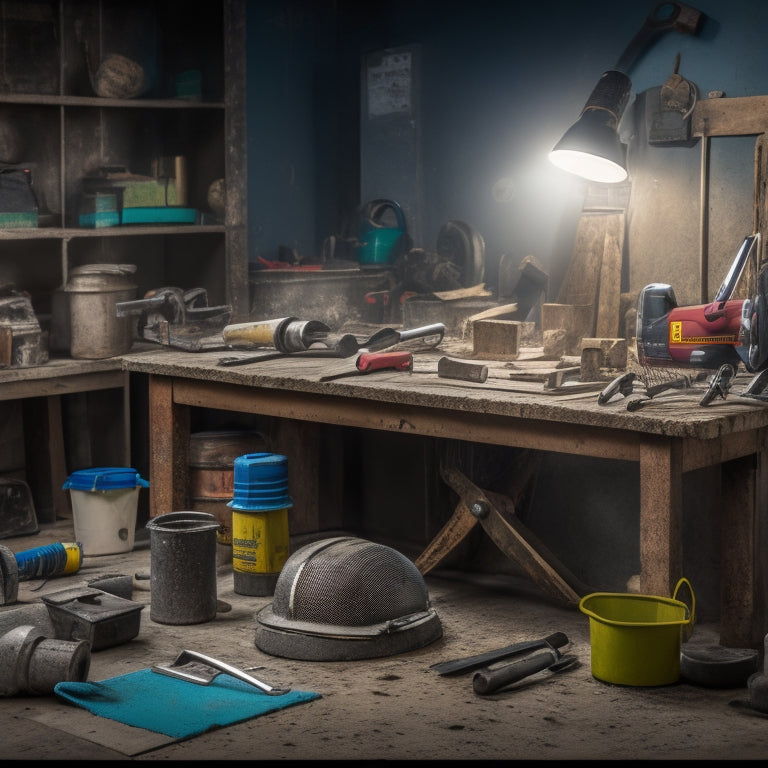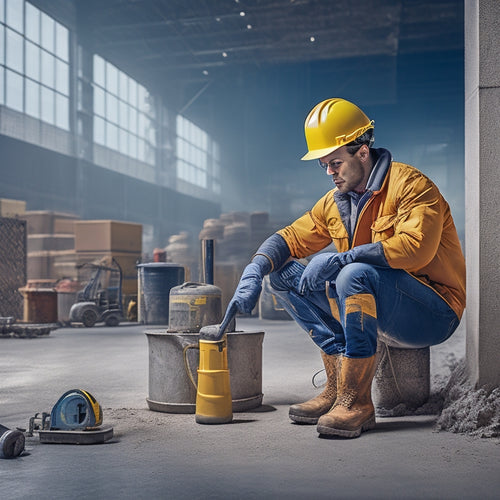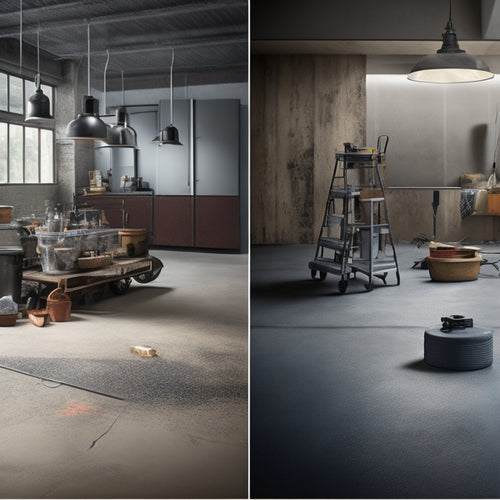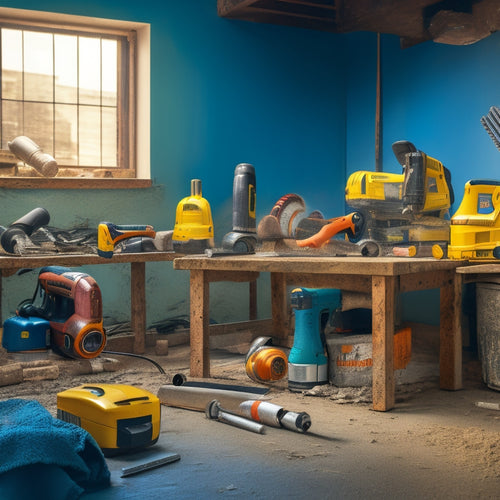
3 Key Tools for Refurbishing Used Concrete Blocks
Share
You'll need three key tools to refurbish used concrete blocks: grinding wheels, cinder block scarifiers, and drum sanders. Grinding wheels remove old mortar and smooth surfaces, with coarser grits ideal for thick mortar removal and finer grits for surface refinement. Cinder block scarifiers, available in walk-behind, ride-on, and handheld options, improve bonding between old and new concrete surfaces. Drum sanders, also in walk-behind and handheld varieties, tackle large and small areas with ease. Mastering these tools is vital to achieving a strong, durable, and visually appealing outcome - and it's just the beginning of what you'll need to know to get the job done right.
Key Takeaways
- Grinding wheels are essential for removing old mortar and smoothing surfaces, with coarse grits for thick mortar and finer grits for surface refinement.
- Cinder block scarifiers, available in walk-behind, ride-on, and handheld models, improve the bond between old and new concrete surfaces.
- Drum sanders, in walk-behind and handheld forms, are ideal for large and small areas, respectively, and require regular maintenance for optimal performance.
- Correct angle and pressure are crucial when using grinding wheels to ensure effectiveness and avoid damage.
- Electric and gas-powered scarifiers are preferred for indoor and outdoor use, respectively, due to their suitability for different environments.
Grinding Wheels for Cinder Blocks
When refurbishing cinder blocks, grinding wheels become an essential tool for removing old mortar, rough edges, and uneven surfaces. You'll need to choose the right grinding wheel for your specific project, considering factors like wheel size, grit, and bond type.
For efficient block preparation, you'll want to select a wheel that effectively removes old mortar without damaging the block. Coarse grit wheels (around 16-20) are ideal for removing thick layers of mortar, while finer grits (36-46) are better suited for smoothing out surfaces.
When it comes to grinding techniques, it's vital to maintain the correct angle and pressure. Hold the grinder at a 20- to 30-degree angle, applying moderate to heavy pressure depending on the wheel's aggressiveness.
Keep the grinder moving in a consistent, overlapping pattern to avoid creating scratches or swirl marks. By perfecting these techniques and selecting the right grinding wheel, you'll be able to achieve a smooth, even surface, ready for re-use or re-installation.
Cinder Block Scarifier Options
You've prepared your cinder blocks by grinding away old mortar and uneven surfaces, but now it's time to take surface preparation to the next level with a cinder block scarifier.
This tool is designed to remove thin layers of concrete, exposing a fresh surface and creating a better bond between the old and new concrete. By using a cinder block scarifier, you can achieve a more even cinder block texture, ideal for refurbishment.
When selecting a cinder block scarifier, consider the following options:
-
Walk-behind scarifiers: Ideal for large areas, these machines are easy to maneuver and provide efficient surface preparation.
-
Ride-on scarifiers: Suitable for massive projects, these machines offer increased productivity and comfort.
-
Handheld scarifiers: Perfect for smaller areas and detail work, these tools provide precision control and versatility.
- Electric vs. gas-powered scarifiers: Choose between electric models for indoor use or gas-powered models for outdoor projects.
Drum Sanders for Concrete Refurbishment
As you progress in refurbishing concrete blocks, a drum sander becomes an vital tool for achieving a smooth, even surface. You'll need to choose the right type of drum sander for your specific project, as there are several options available.
| Drum Sander Type | Description |
|---|---|
| Walk-behind drum sander | Ideal for large, flat areas, these sanders are designed for heavy-duty use. |
| Handheld drum sander | Smaller and more portable, these sanders are perfect for smaller areas and detail work. |
When selecting a drum sander, consider the size of the area you need to sand, the level of sanding required, and the power source you prefer. Regular maintenance is vital to extend the life of your drum sander. This includes cleaning the drum regularly, checking and replacing worn-out sanding belts, and lubricating moving parts. Proper drum sander maintenance guarantees efficient sanding and prevents damage to the tool. By investing in the right drum sander and following a regular maintenance routine, you'll be able to achieve a professional-looking finish on your refurbished concrete blocks.
Frequently Asked Questions
What Safety Gear Is Required When Refurbishing Used Concrete Blocks?
When refurbishing used concrete blocks, you'll need essential safety gear, including protective eyewear to shield your eyes from debris and heavy gloves to prevent cuts and abrasions, ensuring a safe and successful project.
Can Refurbished Concrete Blocks Be Used for Load-Bearing Walls?
Imagine a refurbished block as a reliable teammate, shouldering the weight of your project. Yes, you can use refurbished concrete blocks for load-bearing walls, but only if they meet the required load-bearing capacity and maintain structural integrity after refurbishment.
How Do I Dispose of Dust and Debris From Refurbishment?
When refurbishing concrete blocks, you'll generate dust and debris; for proper dust disposal and debris management, you'll need to vacuum or sweep regularly, and dispose of waste in sealed bags or containers to prevent environmental contamination.
Are There Any Eco-Friendly Refurbishment Methods for Concrete Blocks?
You're not a tree-hugger, but you want to save the planet, right? Good news! You can refurbish concrete blocks using sustainable materials and green practices, like repurposing old blocks, using eco-friendly cleaning agents, and minimizing waste – it's a win-win for your project and the environment.
Can I Refurbish Concrete Blocks With Existing Cracks or Damage?
You can refurbish concrete blocks with existing cracks or damage by applying crack repair compounds and surface treatments, such as epoxy injections or polyurethane coatings, to restore structural integrity and aesthetics.
Conclusion
You've got the right tools in your arsenal to breathe new life into used concrete blocks. Now, imagine reshaping a rough, worn-out block into a smooth, like-new surface - it's like chiseling a masterpiece out of a rough stone. In fact, with the right grinding wheel, scarifier, and drum sander, you can refurbish up to 500 blocks per day, saving time and resources. By excelling with these three key tools, you'll be sculpting a more efficient, cost-effective construction process in no time.
Related Posts
-

10 Best Tools for Sealed Concrete Flooring on Budget
When starting on a sealed concrete flooring project on a budget, you'll need to prioritize essential tools without sa...
-

Top Tools for Revamping Old Concrete Floors
You'll need a range of tools to revamp your old concrete floor, starting with epoxy, acrylic, or polyurethane paint, ...
-

Essential Power Tools for Concrete Block Construction
When building with concrete blocks, you'll need a range of power tools to cut, drill, mix, and finish the blocks to g...


